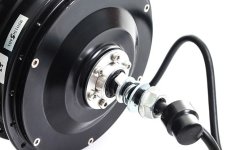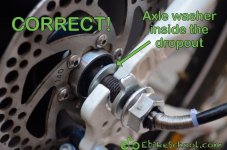ricsha said:
The lead is already terminated so I cant reposition them.
Terminated in what connectors?
Many of them are small enough to fit inside the nuts/washers, either directly or by splitting the phase connectors apart, or removing the contacts from the shell(s).
Whether it will matter depends on the shoulder size of the axle, and the qualities of the steel of the dropout and its' design. If the shoulder is pretty narrow, then there's not a lot of support of the axle against the dropout. The less mating surface area, the more pressure there is against each unit of surface area there is, so the more chance of deformation of the dropout area.
That's why the washer can be important; it spreads that force across more surface area, decreasing the chances of deformation (though the washer is often enough not all that hard a steel, so the shoulder can cut into it and deform it into a "cup" shape (I've had this happen) but it is still better than having it do that to the dropout itself.

Some of the washers (including torque washers) supplied with motors are pretty crappy, both in their fit and in the hardness of the metal, and I've had completely worthless ones and very good ones.
Anyway, if the dropout deforms enough, the nut can loosen (especially if there is nothing to lock it in place with pressure, like a Nordlock or some type of compression washer). If the dropout deforms enough (or is already "loose" enough to start with) to let the axle rock back and forth, it could deform further and/or break. Or if it's harder than the axle steel, the axle could get notched until it spins in the dropouts.
Without testing it with and without the washer, can't say whether it'll make any significant difference in your case, or if any of the above would happen. But those things *have* happened to various motors on various bikes here on ES (including a couple of mine).
What is much better and makes all of the above much less relevant, is a really good torque arm, or pinching / clamping dropout plates. (both of which should be mechanically fastened to the frame / existing dropouts, very securely).





